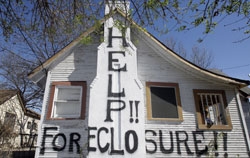It's Time for Debt Forgiveness, American-Style
The rebellious citizens occupying Wall Street shock some people and inspire others with their denunciations of bankers, but everyone seems to know what they are talking about: it is the barbaric and suffocating behavior of the nation’s largest banks (yes, the same ones the government rescued with public money). Right now, these trillion-dollar institutions are methodically harvesting the last possible pound of flesh from millions of homeowners before kicking these failing debtors out of their homes (the story known as the “foreclosure crisis”). This is a tragedy, of course, for the people who are dispossessed. For the country, it is a generational calamity.
“We are in the reverse New Deal,” Christopher Whalen, a savvy banking expert at Institutional Risk Analytics, told me. He meant that events are dismantling the ingenious engine that helped generate America’s broad middle class. Homeownership was the main driver in accomplishing that great social change. For three generations, people of modest means could buy a house knowing it would secure their place in the middle class and allow them to accumulate significant savings. If the family held the standard thirty-year, fixed-rate mortgage, they were painlessly saving for the future every time they made a payment, acquiring greater equity in the home as they did so. With moderate inflation, the house would steadily increase in value even as their monthly mortgage payments stayed the same. So the cost of housing actually declined for the family, as a percentage of its income. Meanwhile, the accumulating equity became a nest egg for retirement or something to pass on to the kids.
That virtuous process, originated by New Deal reforms, is in peril and has already shut down for tens of millions, especially working-class families whose incomes are no longer rising. As described by the brokerage investment firm Amherst Securities, the housing picture is ugly. Among the 55 million families with mortgages, one in five is underwater—they owe more on their mortgage than their house is worth—or already delinquent. That’s 10.4 million families who are sliding toward failure and foreclosure. Virtually all of them will become renters, since no bank is likely to give them a new mortgage.
As a result, the housing market will remain depressed for years—too many houses for sale, too few buyers. Amherst estimates excess supply of 4–6 million in the next six years. Economic recovery may have to wait until that surplus is gone, because the housing sector has always led the way out of recession. The more housing supply exceeds demand, the more prices fall. The more prices fall, the more families get sucked into the deep muddy. The vicious cycle is known in the industry as the death spiral. So far, there’s no end in sight.
Laurie Goodman, a senior managing director and housing-finance expert at Amherst, warns Washington audiences, “There is a cost for doing nothing. You just kick the problem down the road; you don’t solve it. Then home prices deteriorate more and you re-create the death spiral in housing, as lower prices mean more borrowers are underwater.”
Conservatives preach patience and resignation: nothing to do except wait until the destruction ends. Liberals insist this is a solvable problem, if only government would act forcefully.
* * *
There is a solution, and it will appeal to the rebellious spirits occupying Wall Street because it combines a sense of social justice with old-fashioned common sense. It is forgiveness—forgive the debtors. Write down the principal they owe on their mortgage to match the current market value of their home, so they will no longer be underwater. Refinance the loan with a reduced interest rate, so the monthly payment is at a level that the struggling homeowner can handle. This keeps families in their homes, with a renewed stake in the future. It gives homeowners incentive to keep up their payments, because once again they have some equity and the opportunity to accumulate much more.
Some people are morally offended by the idea, and not just bankers. Forgiveness sounds to them like old-fashioned bleeding-heart liberalism. Letting failed borrowers off the hook encourages bad habits, they say, the so-called “moral hazard” of inviting others to skip their debt payments too. Forgiveness does require a measure of sympathy—a sentiment in scarce supply among governing elites. Policy wonks and politicians have been taught by a generation of hard-boiled titans and their business-school apologists to brush aside fellow feeling and focus only on the bottom line. The common good, conservatives claim, is best served by adhering to the unsentimental economics of “me first, never mind the losers.” That pernicious doctrine still reigns in the political culture. It is what the people in the Occupy Wall Street movement are rebelling against.
Forgiving the debtors is the right thing to do, because the bankers have already been forgiven. The largest banks were in effect relieved of any guilt—for their crimes of systemic fraud or for causing the financial breakdown—when the government bailed them out, no questions asked. The Obama administration followed up with a very forgiving regulatory policy that basically looked the other way and ignored the fictional claims on bank balance sheets. Instead of forcing honest accounting and rigorous reform, the administration adopted a strategy of soft-hearted regulation that banking insiders call “extend and pretend”: extend the failed loans and pretend that the loans will be paid off, even when you know many of them won’t. The phrase originated during the third world debt crisis in the 1980s, when the Federal Reserve rescued the same big banks from insolvency, the result of their reckless lending in Latin America.
This time, the government’s rationale for rescuing bankers first was that the economy cannot recover until the financial system is healed. The premise did not prove out—banks revived, at least partially, but not the economy. The same rationale applies, more logically, to failing homeowners. A heavy blanket of bad debt is smothering economic activity. Until the debt is lifted from the housing market and financial balance sheets, the economy is unlikely to regain its normal energies. So debt forgiveness is not just a moral imperative; it’s also an economic necessity.
The largest and most powerful banks are standing in the way of this solution. The Obama administration is standing with them, because bankers and other creditors would have to take a big hit if they were forced to write down the debt owed by borrowers. The banks would have to report reduced capital and their revenue would decline if homeowners were allowed to make smaller monthly payments. This could threaten the solvency of some very large banks—those that have been exaggerating their financial condition, as many market analysts and shareholders suspect. That risk presumably explains why the Treasury Department and various housing agencies try to dodge the growing demands for debt forgiveness. Fannie Mae and Freddie Mac, which guarantee roughly 70 percent of all mortgages and are now virtually owned by the government, have flatly rejected the idea, and so have the Federal Housing Administration and the Veterans Administration.
“It’s sinful, is the word I would use, that they won’t do this,” says John Taylor, president of the National Community Reinvestment Coalition and a longtime advocate for housing.
President Obama seems to be playing a sly double game—protecting banks from sharing the pain while proclaiming sympathy for embattled homeowners. The government, in effect, has been sheltering banks from facing the hard truth about their condition. They may be valuing mortgages or mortgage bonds at, say, 85 cents on the dollar when the true market value, industry experts say, is closer to 25 or 30 cents. That strengthens the case for a general and orderly write-down now: if many of these loans aren’t ever going to be repaid, then the assets now claimed by the banks are imaginary. Plus the banks hold nearly all the secondary mortgages (often equity lines) on the same houses. They are sure to fail too if the prime mortgages are busted.
* * *
The issue of forgiveness has little traction in mainstream debate, but prospects for action are far more promising than cynics assume. I am convinced that the debt-forgiveness question will eventually move to center stage, if not with this president then maybe the next one. If it is not dealt with, the problem will become larger and more destructive. The politics will change when the public realizes that the economy will remain stagnant until banks are forced to a reckoning and the huge overhang of bad debt is eliminated.
My evidence for optimism is a sampling of authorities from the financial system—banking and housing experts, financial economists, even a few investment bankers—who are already calling for debt reduction. Moral sentiment aside, people who know how the financial system works understand the ugly consequences of doing nothing. The industry advocates of dramatic write-downs are not radicals, but the logic of their position has so far been largely ignored by the major media. Active citizens are spreading the word, however. While Lower Manhattan was being occupied, the New Bottom Line, a coalition of community groups, church folks and other networks, was staging daily clashes with big banks around the country. George Goehl of National People’s Action sees the level of direct action and nonviolent civil disobedience rising rapidly among frustrated people of conscience.
Stephen Roach, a Morgan Stanley economist and lecturer at the Yale University School of Management, more or less agrees. “Some form of debt forgiveness would be a clear positive,” Roach told me. “Debt forgiveness is a big deal when so many Americans are underwater and unable to keep up with their payments. Writing off debts would help them build up their savings. The saving rate is up, but not nearly enough. With debt reduction, people would feel less reluctant to spend money on new things. If you can do that, then companies will feel more confident about future demand, less reluctant about hiring more workers.”




















